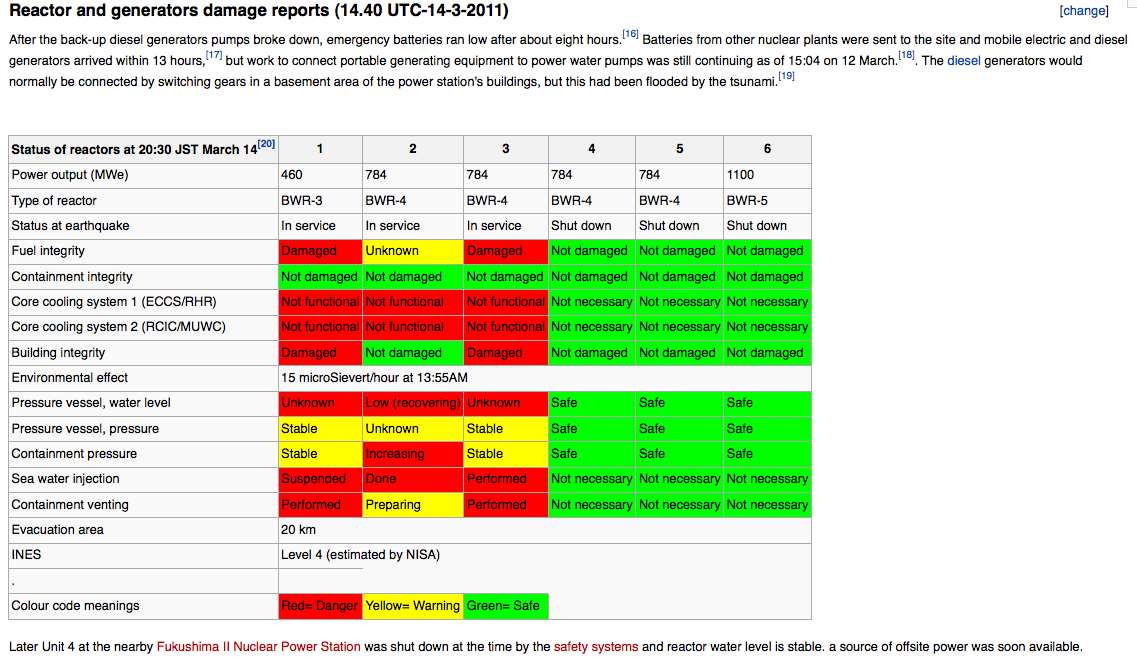Fukushima Daiichi reactor 3 aerial from Digital Global
Submitted by Jeff Buster on Mon, 03/14/2011 - 18:40.

Not looking too promising in this Digital Global satelite view. You can see the roof damage to units 1 (lower left) and unit 3 (smoking in the center). Fortunately, the wind is mostly headed to sea.
Here is a screen grab of a Damage Report from Wikipedia for all 6 reactors at Fukushima. Wikipedia is spectacular: While the encyclopedia used to be a printed heavy static book - today the ad-free Wikipedia volunteer encyclopedia is as fast as light and the human drive to organize and inform.

( categories: )
|
winds
I hear that the fuel rods are exposed. What is on the other side of the sea in the wind direction? And, yes, it is fortunate that the winds is blowing to the sea; otherwise, the death toll would drastically increase.
North America is downwind from Fukushima - always has been
a run on iodine tablets
Maybe the folks at the local nuke plants will release their stock of iodine tablets.
I have been pondering the unintentional pay back issue. I actually encountered someone this weekend who asked people to remember Pearl Harbor before they contributed any money for the efforts in Japan, as they are totally forgetting what the US did to Nagasaki and Hiroshima, and the world.
Since the fuel rods are exposed, is a total meltdown a given?
Pearl Harbor Naval Station vs Nagasaki and Hiroshima
If people are still resentful about Pearl Harbor, I would ask them to consider:
There are "rules" of war which differentiate between attacking civilian targets and military targets. The American media is blaring those "rules" now with regard to Libya = threats of International Criminal Court and the Geneva Convention are heard.
The Japanese caught the US Navy war ships on a Sunday morning completely off guard. Like a hockey player against the boards is fun sport - the US Navy got CHECKED bigtime. That's how the sport of war is played. Not my game...
But in return for being badly checked, the US used not one, but two, unnecessary nuclear bombs on masses of civilians. And we did it very intentionally. We were sore sports in the game.
How would the International Criminal Court have ruled today with our WWII atom bombs?
good question
But the US has frequently said one thing and did another.
-
-
and what would happened if a meltdown
and what would happen to the adjacent reactors if a meltdown (total meltdown) happened at one reactor? Isn't the emergency cooling of the rods at the other reactors dependent on people being there to run the cool down of sea water?
more on meltdown
From www.guardian.co.uk/world/2011/mar/14/fukushima-nuclear-power-plant-japan
Nuclear scare grows with an orange flash and a violent blast
Officials at Tepco said it believed all three nuclear reactors are likely to have suffered partial meltdowns, though this could mean just one fuel rod or nearly all of them melting within the cores. The reactors are at risk of going into meltdown because although they had shut down, the fuel rods continue to give off heat. Primary and backup power to the cooling systems was knocked out during the massive earthquake and tsunami that struck on Friday.
AND THIS
In Stricken Fuel-Cooling Pools, a Danger for the Longer Term
"Even as workers race to prevent the radioactive cores of the damaged nuclear reactors in Japan from melting down, concerns are growing that nearby pools holding spent fuel rods could pose an even greater danger. "
"Were the spent fuel rods in the pools to catch fire, nuclear experts say, the high heat would loft the radiation in clouds that would spread the radioactivity.
“It’s worse than a meltdown,” said David A. Lochbaum, a nuclear engineer at the Union of Concerned Scientists who worked as an instructor on the kinds of General Electric reactors used in Japan. “The reactor is inside thick walls, and the spent fuel of Reactors 1 and 3 is out in the open.”
Radioactive "dust" everyone?
If the fuel rods catch fire in Japan, far more than the west coast of North America would receive a radioactive "dusting."
Depending on what, where, and when
Depending on what, where, and when one reads about the nuclear meltdowns in Japan, things are either critical or things are ok.
Per Rueters, at 6:56 PM: Radiation poses only a slight risk to Tokoyo
"My instinct tells me it is probably not a health concern for the long term," said Dr. John Chute, a cancer biology expert at Duke University School of Medical Center. But because radiation is so poorly understood, Chute said taking steps to prevent exposure just makes sense.
"If it were me, I'd stay indoors.
But at 3:54 PM, the LA Times, reports more quakes and risk.
my daughter in portland, oregon sent me this:
http://bravenewclimate.com/2011/03/13/fukushima-simple-explanation/
my take on it?
they are simply preparing them to unknowingly accept contamination.
Imagine what impact the US economy would take if the west coast were toxic?
bravenewclimate
They actually say By “significant” I mean a level of radiation of more than what you would receive on – say – a long distance flight, or drinking a glass of beer that comes from certain areas with high levels of natural background radiation.
Is this a release from the nuke industry?
good question
please pray for my powers of persuasion.
she has a good (union) job and Portland is relatively free of lead-poisoned whack jobs.
praying
but people can't see radiation, and the young are immortal.
Maybe send some studies of the follow up research on people from the area around Hiroshima and Nagasaki. That might be more persuasive than calls from her mother.
-
-
the graph of damage to reactors
It says that cooling is not necessary for reactor 4 (shut down), but what about 5, and 6. Are they also shut down?